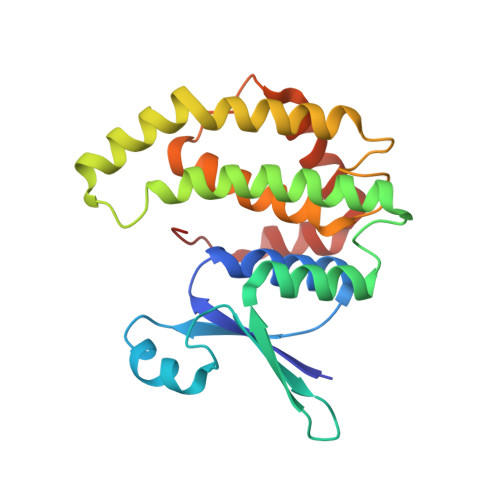Probing the Mechanism of Gsh Activation in Schistosoma Haematobium Glutathione-S-Transferase by Site-Directed Mutagenesis and X-Ray Crystallography.
Baiocco, P., Gourlay, L.J., Angelucci, F., Fontaine, J., Herve, M., Miele, A.E., Trottein, F., Brunori, M., Bellelli, A.(2006) J Mol Biol 360: 678
- PubMed: 16777141
- DOI: https://doi.org/10.1016/j.jmb.2006.05.040
- Primary Citation of Related Structures:
2C80, 2C8U, 2CA8, 2CAI, 2CAQ, 2F8F - PubMed Abstract:
During turnover, the catalytic tyrosine residue (Tyr10) of the sigma class Schistosoma haematobium wild-type glutathione-S-transferase is expected to switch alternately in and out of the reduced glutathione-binding site (G-site). The Tyrout10 conformer forms a pi-cation interaction with the guanidinium group of Arg21. As in other similar glutathione-S-transferases, the catalytic Tyr has a low pKa of 7.2. In order to investigate the catalytic role of Tyr10, and the structural and functional roles of Arg21, we carried out structural studies on two Arg21 mutants (R21L and R21Q) and a Tyr10 mutant, Y10F. Our crystallographic data for the two Arg21 mutants indicate that only the Tyrout10 conformation is populated, thereby excluding a role of Arg21 in the stabilisation of the out conformation. However, Arg21 was confirmed to be catalytically important and essential for the low pKa of Tyr10. Upon comparison with structural data generated for reduced glutathione-bound and inhibitor-bound wild-type enzymes, it was observed that the orientations of Tyr10 and Arg35 are concerted and that, upon ligand binding, minor rearrangements occur within conserved residues in the active site loop. These rearrangements are coupled to quaternary rigid-body movements at the dimer interface and alterations in the localisation and structural order of the C-terminal domain.
Organizational Affiliation:
Department of Biochemical Sciences A. Rossi Fanelli and Istituto Pasteur- Fondazione Cenci Bolognetti, University of Rome La Sapienza, Rome, Italy.
















